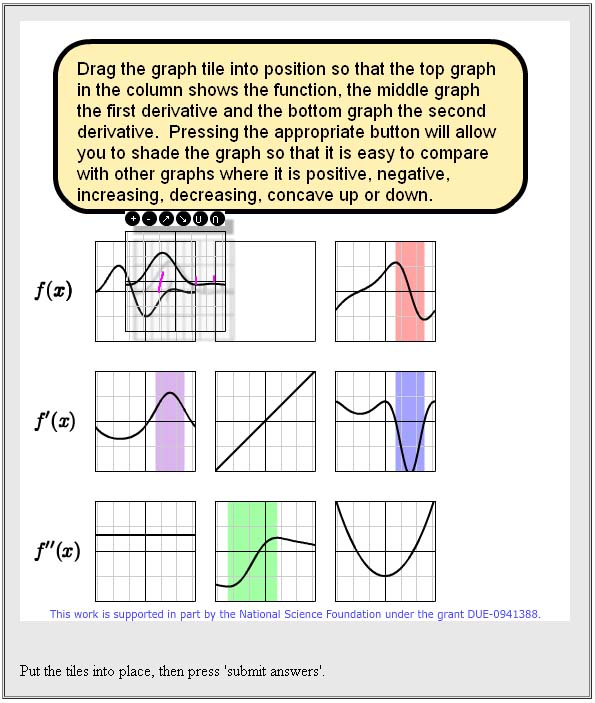Derivative Graph Matching Flash Applet Sample Problem
Flash Applets embedded in WeBWorK questions derivative graph matching Example
Sample Problem with derGraphMatchWW.swf embedded
This sample problem shows how to use the derivative graph matching applet.
A standard WeBWorK PG file with an embedded applet has six sections:
- A tagging and description section, that describes the problem for future users and authors,
- An initialization section, that loads required macros for the problem,
- A problem set-up section that sets variables specific to the problem,
- An Applet link section that inserts the applet and configures it, (this section is not present in WeBWorK problems without an embedded applet)
- A text section, that gives the text that is shown to the student, and
- An answer and solution section, that specifies how the answer(s) to the problem is(are) marked for correctness, and gives a solution that may be shown to the student after the problem set is complete.
The sample file attached to this page shows this; below the file is shown to the left, with a second column on its right that explains the different parts of the problem that are indicated above. A screenshot of the applet embedded in this WeBWorK problem is shown below:

There are other sample problems using applets: GraphLimit Flash Applet Sample Problem, GraphLimit Flash Applet Sample Problem 2
| PG problem file | Explanation |
|---|---|
##DESCRIPTION
## understanding derivatives graphically
##ENDDESCRIPTION
##KEYWORDS('derivatives', 'graph')
## DBsubject('Calculus')
## DBchapter('Limits and Derivatives')
## DBsection('Derivatives')
## Date('7/25/2011')
## Author('Barbara Margolius')
## Institution('Cleveland State University')
## TitleText1('')
## EditionText1('2011')
## AuthorText1('')
## Section1('')
## Problem1('')
########################################################################
# This work is supported in part by the National Science Foundation
# under the grant DUE-0941388.
########################################################################
|
This is the tagging and description section of the problem. Note that any line that begins with a "#" character is a comment for other authors who read the problem, and is not interpreted by WeBWorK. The description is provided to give a quick summary of the problem so that someone reading it later knows what it does without having to read through all of the problem code. All of the tagging information exists to allow the problem to be easily indexed. Because this is a sample problem there isn't a textbook per se, and we've used some default tagging values. There is an on-line list of current chapter and section names and a similar list of keywords. The list of keywords should be comma separated and quoted (e.g., KEYWORDS('calculus','derivatives')). |
DOCUMENT(); # This should be the first executable line in the problem. loadMacros( "PGanswermacros.pl", "PGstandard.pl", "AppletObjects.pl", "MathObjects.pl", ); |
This is the initialization section of the problem. The first executed line of the problem must be the
The |
# Set up problem
TEXT(beginproblem());
$showPartialCorrectAnswers = 1;
Context("Numeric");
$ans =Compute("1");
$showSolution = 0;
if(time>$dueDate){
$showSolution = 1;
}
$isit2der = 1; #match first and second derivatives
|
This is the problem set-up section of the problem.
The derGraphMatchWW.swf applet requires the student to match three sets of graphs. If |
###################################
# Create link to applet
###################################
$appletName = "derGraphMatchWW";
$applet = FlashApplet(
codebase => findAppletCodebase("$appletName.swf"),
appletName => $appletName,
appletId => $appletName,
setStateAlias => 'setXML',
getStateAlias => 'getXML',
setConfigAlias => 'setConfig',
getConfigAlias => 'getConfig',
maxInitializationAttempts => 5, # number of attempts to initialize applet
answerBoxAlias => 'answerBox',
height => '600',
width => '550',
bgcolor => '#ffffff',
debugMode => 0,
submitActionScript =>
qq{getQE("answerBox").value=getApplet("$appletName").getAnswer() },
);
###################################
# Configure applet
###################################
#initialization data - problem setup
# $problemSeed - random seed used to setup problem
# $isit2der - set to 1 if student must match function
# to first and second derivate
# - set to 0 if student must match function
# to first derivative
# $showSolution - set to 1 if $dueDate is passed, 0 otherwise
# success - 0 if work not complete yet
$applet->configuration(qq{<xml><seed>$problemSeed</seed><isit2der>$isit2der</isit2der>
<showSolution>$showSolution</showSolution><stat success="0"/></xml>});
$applet->initialState(qq{<xml><seed>$problemSeed</seed><isit2der>$isit2der</isit2der>
<showSolution>$showSolution</showSolution><stat success="0"/></xml>});
TEXT( MODES(TeX=>'object code', HTML=>$applet->insertAll(
debug=>0,
includeAnswerBox=>1,
# reinitialize_button=>$permissionLevel>=10,
)));
|
This is the Applet link section of the problem.
Those portions of the code that begin the line with You must include the section that follows The lines The code
When the submit button is pressed the work in the applet is checked via the WeBWorK answer checker. The data from the hidden form fields is used in these simple perl subroutines to define the correct answers to the four questions that are part of this WeBWorK problem. The WeBWorK variable $answerString1 is the content of the hidden form field "inc". $correctAnswer1 is the solution to the first question. The solutions for the next two questions are defined in a similar way. |
BEGIN_TEXT
$BR
$BR list all intervals for which
$BR
a)
\(f^\prime(x)>0\)
\{ans_rule(35) \}
$BR
b)
\(f^\prime(x)<0\)
\{ans_rule(35) \}
$BR
c)
\(f^\prime(x)=0\)
\{ans_rule(35) \}
$BR
END_TEXT
Context()->normalStrings;
|
This is the text section of the problem. The
Mathematical equations are delimited by
There are a number of variables that set formatting: |
############################################################## # # Answers # ## answer evaluators ANS( $correctAnswer1->cmp(strings=>['None']) ); #checks AnSwEr00001 ANS( $correctAnswer2->cmp(strings=>['None']) ); #checks AnSwEr00002 ANS( $correctAnswer3->cmp(strings=>['None']) ); #checks AnSwEr00003 ENDDOCUMENT(); |
This is the answer section of the problem. The problem answer is set by the The solution is embedded in the applet and becomes available when the due date has passed.
The |